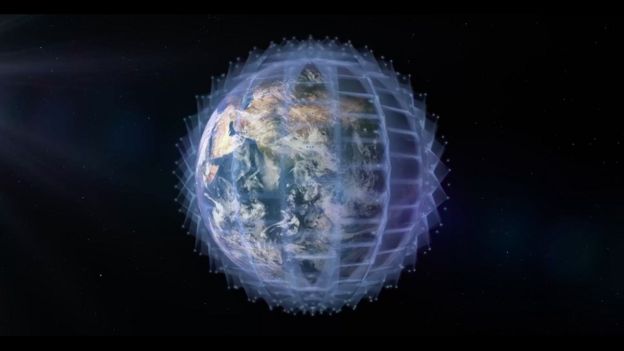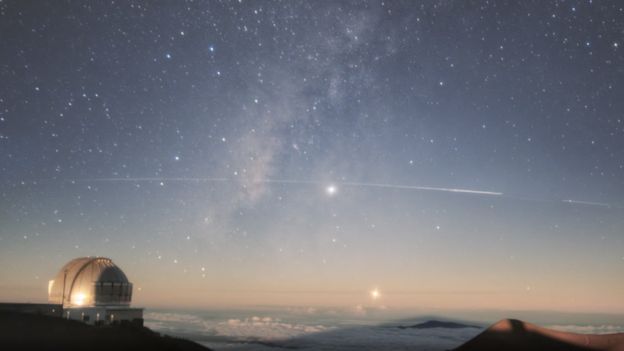विज्ञानियों ने पता लगाया है उपग्रह निगम २०२० के लगते ही हज़ारों माइक्रो -सैटेलाइट्स पृथ्वी के निकट कक्षा में स्थापित करने का मन बना चुकें हैं। बेशक इससे अंतरिक्ष आधारित तेज़तर्रार इंटरनेट सेवाएं मिलने लगेंगी लकिन इसकी खगोल विदों को भारी कीमत चुकानी पड़ सकती है।हों की
एक औसत मेज़ के आकार के ये उपग्रह नाइट स्काई लाइन को बाधित कर सकते हैं। ये बड़े पैमाने पर रेडिओ फ्रीकवेंसीज़ काम में लेंगे।
बचपन में आपने भी खुले आकाश की छत के नीचे आसमान के तारे गिनने की होड़ में खुद को शरीक किया होगा। कहीं हज़ारों उपग्रहों की यह श्रृंखला (एक पूरा नेटवर्क )एक त्रासदी की सृष्टि न कर देवे ऐसी आशंका वर्तमान खगोल विज्ञान के माहिरों ने अभिव्यक्त की है ,ये एक बड़ा उपग्रह नेटवर्क होगा जो उस खिड़की को झरोखे को बाधित कर सकता है जो हमें शेष सृष्टि के होने की खबर देती है उसी विंडो में ये उपग्रह कड़ी व्यतिरेक पैदा कर सकती है। इंटरफेयर कर सकती है उस खिड़की को।
प्रकाशीय दूरबीनों से प्राप्त इमेजेज को भी इनमें प्रयुक्त आवृत्तियाँ विघटित (विच्छिन्न )कर सकतीं हैं। विघ्न पैदा कर सकतीं हैं इनमें।
इन छोटे आकार वाले उपग्रहों से बड़ी मात्रा में (इंटेंसिटी )में प्रकाश लौटता है। ये नन्ने उपग्रह कुछ ज़रा ज्यादा ही परावर्तनशील (रिफ्लेक्टिव )हैं।
दूसरे शब्दों में समझें तो ये उपग्रह अंतरिक्ष से प्राप्त उन सिग्नलों को सूचना संकेतों को तहस नहस कर देंगें जिनका इस्तेमाल खगोल शास्त्री करते आये हैं। अंतरिक्ष पिंडों के स्थान पर हमें इन्हीं उपग्रहों के चित्र प्राप्त होंगें क्योंकि परसिहत पृष्ट -भूमि में यही तो डॉट्स के माफिक होंगे।
पृथ्वी की और बढ़ते एस्टेरॉइड्स (लघु ग्रहों की वह पट्टी जो मंगल और गुरु बृहस्पति की कक्षाओं के मध्य में होती हैं वहीँ से ये लघुग्रह पृथ्वी की तरफ आते हैं। सर्व प्रथम यही दृष्टि क्षेत्र में आयेंगे।चित्र के सर्वप्रमुख भाग -अगले भाग में यही दिखलाई देंगे।ऐसे हम उन संभावित यद्यपि विरले ही पृथ्वी की ओर खतरनाक तरीके से बढ़ते लघुग्रहों की हम कोई टोह नहीं लगा पाएंगे। खगोल विदों की यह आशंका निर्मूल नहीं कही जायेगी।
 ONEWEBB
ONEWEBB
To give you an idea of the numbers, there are currently just 2,200 active satellites flying around the Earth.
But as of next week, the Starlink constellation - a project by US company SpaceX - will start sending batches of 60 satellites into orbit every few weeks. This will mean about 1,500 satellites have been launched by the end of next year, and by the mid-2020s there could be a fleet of 12,000.
UK company OneWeb are aiming for about 650 satellites - but this could rise to 2,000 if there is enough customer demand.
While Amazon have a constellation of 3,200 spacecraft planned.
Why are astronomers worried?
In May and November, Starlink sent 120 satellites into orbits below 500km.
But stargazers were concerned when the spacecraft appeared as bright white flashes on their images.
 GEMINI OBSERVATORY/ NSF
GEMINI OBSERVATORY/ NSF
Dhara Patel, an astronomer at the Royal Observatory Greenwich said: "These satellites are about the size of a table, but they're very reflective, and their panels reflect lots of the Sun's light, which means that we can see them in images that we take with telescopes.
"These satellites are also big radiowave users… and that means they can interfere with the signals that astronomers using. So it also affects radio astronomy as well."
She warns that problem will grow as the numbers of satellites in orbit increase.
What could this mean for research?
Dr Clements believes the satellites could have a real impact on observations.
"They present a foreground between what we're observing from the Earth and the rest of the Universe. So they get in the way of everything.
"And you'll miss whatever is behind them, whether that's a nearby potentially hazardous asteroid or the most distant Quasar in the Universe."
He said it would be particularly troublesome for telescopes taking large surveys of the sky, such as the future Large Synoptic Survey Telescope (LSST) in Chile.
He explained: "What we want to do with LSST and other telescopes is to make a real-time motion picture of how the sky is changing...
"Now we have these satellites that interrupt observations, and it's like someone's walking around firing a flashbulb every now and again."
But Prof Martin Barstow, an astrophysicist from the University of Leicester said some of the problems could be fixed.
"The numbers of satellites do sound frightening, but actually space is big - so when you superimpose them all on the sky, the density of these things is not going to be very large," he said.
"And because the satellites have known positions, you can mitigate. A satellite is going to be a dot in an image and it might appear as a transient burst of light - but you will know about it and can remove it from the image.
"It will cost effort and work for observatories to deal with it, but it can be done."
For radioastronomy, however, the constellations could pose more of an issue - especially for relatively new telescopes, such as the Square Kilometre Array (SKA).
The radio signals the satellites use will be different from the ones astronomers are looking for, but they could still interfere, said Prof Barstow.
What do the companies involved say?
 AFP
AFP
SpaceX told the BBC that they were actively working with international astronomers to minimise the impact of the Starlink satellites.
For their next launch, they are trialling a special coating that is designed to make the spacecraft less bright to see if this will help.
OneWeb said they wanted to be a "thought leader in responsible space" and were putting their satellites into an orbit of 1,200km so they would not interfere with astronomical observations.
Ruth Pritchard-Kelly, vice president of OneWeb, said: "We chose an orbit as part of our dedication to responsible use of outer space… And we've also talked to the astronomy community before we launched to make sure that that our satellites won't be too reflective, and that there won't be radio interference with their radio astronomy."
She added that it shouldn't be a case of having to choose between connectivity and astronomy.
"There is no question that the entire world is entitled to be connected to the internet…. So it's going to happen. And probably three or four of these systems are going to happen," she said.
"And the question will be working with the other stakeholders to make sure that we're not interfering with them, whether they are existing satellite technologies, or the mobile phone on the ground, or the astronomy community.
"We know we're going to work it out with everybody."
Stargazers will be watching the skies to see if a compromise can be found.
कोई टिप्पणी नहीं:
एक टिप्पणी भेजें